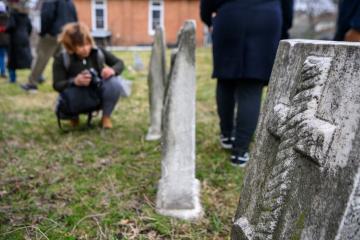- Name
- Jill Rosen
- jrosen@jhu.edu
- Office phone
- 443-997-9906
- Cell phone
- 443-547-8805
A baby photo. Taped interviews with childhood friends. Handwritten set lists on crumpled paper. With a newly acquired collection of Billie Holiday biographical materials, Johns Hopkins University historians are piecing together details about the jazz singer's largely unknown early life in Baltimore.
The collection, parts of which will be on display during a sold-out event at the Baltimore Museum of Art on Thursday, April 13, is part of an effort to better understand Baltimore's influence on Billie Holiday and to shed light on Black life in the city at that time.
"Billie Holiday is beloved by people all over the world, but she grew up in Baltimore. As a university with incredible resources that's located here, it really makes sense for us to invest in understanding Holiday's life and music—not just for their own sake but also as a way to better understand this city's history, in particular this city's Black community and Black culture," said curator Gabrielle Dean, the William Kurrelmeyer Curator of Rare Books and Manuscripts in the university's Sheridan Libraries. "Billie Holiday is kind of like a poster child for all of the Baltimore stories we haven't told yet."
Johns Hopkins Sheridan Libraries started collecting Billie Holiday materials years ago—a difficult endeavor, says Dean, because they are hard to come by and not often available for acquisition. This collection, amassed by a Billie Holiday biographer during the 1970s and stored during the last 30 years by a private collector, is considered the most significant Billie Holiday material to be made available in decades. When Johns Hopkins historians heard that the collector was selling the lot, they pounced.
The new collection includes the earliest known photo of Billie Holiday—a posed studio shot taken in 1917 when she was 2 years old—ephemera such as programs from clubs, hand-written set lists, and a grocery shopping list. But Johns Hopkins historians say the most revelatory items are 140 taped interviews with not only musicians and jazz scholars but Holiday's childhood friends and neighbors from Baltimore.
One interview is with a friend who describes injecting Holiday with heroin in Druid Hill Park in the 1950s.
"For my money most of the interviews force us to rethink our point of view about under what terms does Holiday become a sophisticated and distinct musical voice," said Bloomberg Distinguished Professor Lawrence Jackson, who's leading the Holiday research. "For me the interviews help us to think about what effect the place of her nativity has on her art form, which has never been considered in any significance whatsoever."
Jackson, a fourth generation Baltimorean who directs the university's Billie Holiday Center for the Liberation Arts, which is an effort to link Johns Hopkins with the city's historical African-American communities, is trying to better understand Holiday's Baltimore childhood in order to better understand her music. He wants to know how Baltimore shaped her art.
To that end, he's diving deep into historical records, maps, and even old police reports to figure out everything from where she lived, where she went to school, and what else was in those neighborhoods that might have been part of her everyday life.
For Jackson, who's deeply interested in Baltimore's jazz origins, a key aspect of the research is also understanding what music Holiday would have heard as a girl.
"Baltimore musicians created a sound and a unique sense of performance that seems to be fundamental in Holiday's own expression," Jackson said. "She was thought of as a microphone singer and she inevitably and without a doubt, for me, picked up the performance style and the musical education of the people of both east and west Baltimore."
He sees how the time she spent on Pratt Street performing as a young adult, and even the time she spent as a sex worker in the good-time houses of Dallas Street, contributed to her phrasing and rhythm.
"It's coming from that moment," he said. "Her phrasing, her drawl, and the sound of her voice is what's so electric and magnetic about her, why she's considered the consensus greatest jazz vocalist, but it's also a combination of common southern Maryland and 'hep' with an urban zing."
The taped interviews are the most fascinating elements in the collection, Jackson and Dean agree. No small part of that, they say, is rare access to largely unheard voices of Black Baltimoreans.
"These are voices of African Americans from the bottom of the social order, and to have their point of view on anything, let alone on someone who became the greatest jazz vocalist, is remarkable," Jackson said.
Thursday's event at the Baltimore Museum of Art, The Birth of Jazz: Billie Holiday's Baltimore, will feature a talk by Holiday biographer Robert O'Meally, and jazz performances by Candice Hoyes and Sean Jones.
"It will be a multilayered experience," said Raynetta Wiggins-Jackson, an Africana Archives Curatorial Fellow at Johns Hopkins who's coordinating the event. "You get the art, you get to learn about it and then you get historical documents from the city focusing on early jazz in Baltimore and also on Billie Holiday's growth as Baltimore artist."
Posted in Arts+Culture, Community
Tagged community, sheridan libraries, billie holiday center for liberation arts










